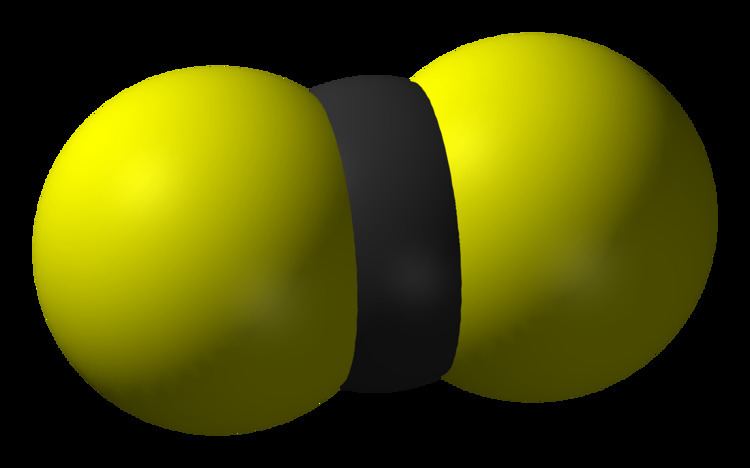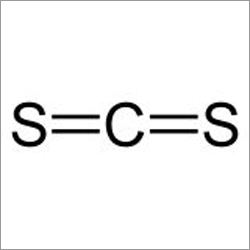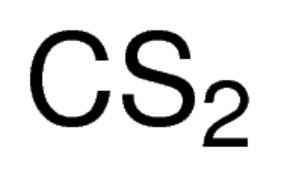Formula CS2 Molar mass 76.139 g/mol Density 1.26 g/cm³ Classification Sulfide | IUPAC ID Carbon disulfide Boiling point 46.3 °C Melting point -110.8 °C | |
 | ||
Appearance Colorless liquidImpure light-yellow Related compounds Thermodynamicdata Phase behavioursolid–liquid–gas | ||
Molecular formula of carbon disulfide 008
Carbon disulfide is a colorless volatile liquid with the formula CS2. The compound is used frequently as a building block in organic chemistry as well as an industrial and chemical non-polar solvent. It has an "ether-like" odor, but commercial samples are typically contaminated with foul-smelling impurities.
Contents
- Molecular formula of carbon disulfide 008
- Make carbon disulfide
- Occurrence manufacture properties
- Solvent
- Reactions
- Chlorination
- Coordination chemistry
- Polymerization
- Uses
- Niche uses
- Health effects
- References

Make carbon disulfide
Occurrence, manufacture, properties

Small amounts of carbon disulfide are released by volcanic eruptions and marshes. CS2 once was manufactured by combining carbon (or coke) and sulfur at high temperatures.
C + 2S → CS2
A lower-temperature reaction, requiring only 600 °C, utilizes natural gas as the carbon source in the presence of silica gel or alumina catalysts:
2 CH4 + S8 → 2 CS2 + 4 H2S
The reaction is analogous to the combustion of methane. It is isoelectronic with carbon dioxide. CS2 is highly flammable:
CS2 + 3 O2 → CO2 + 2 SO2Global production/consumption of carbon disulfide is approximately one million tonnes, with China consuming 49%, followed by India at 13%, mostly for the production of rayon fiber. United States production in 2007 was 56,000 tonnes.
Solvent
Carbon disulfide is a solvent for phosphorus, sulfur, selenium, bromine, iodine, fats, resins, rubber, and asphalt. It has been used in the purification of single-walled carbon nanotubes.
Reactions
Compared to CO2, CS2 is more reactive toward nucleophiles and more easily reduced. These differences in reactivity can be attributed to the weaker π donor-ability of the sulfido centers, which renders the carbon more electrophilic. Amines afford dithiocarbamates:
2 R2NH + CS2 → [R2NH2+][R2NCS2−]Xanthates form similarly from alkoxides:
RONa + CS2 → [Na+][ROCS2−]This reaction is the basis of the manufacture of regenerated cellulose, the main ingredient of viscose, rayon and cellophane. Both xanthates and the related thioxanthates (derived from treatment of CS2 with sodium thiolates) are used as flotation agents in mineral processing.
Sodium sulfide affords trithiocarbonate:
Na2S + CS2 → [Na+]2[CS32−]Carbon disulfide does not hydrolyze readily, although the process is catalyzed by an enzyme carbon disulfide hydrolase.
Chlorination
Chlorination of CS2 is the principal route to carbon tetrachloride:
CS2 + 3 Cl2 → CCl4 + S2Cl2This conversion proceeds via the intermediacy of thiophosgene, CSCl2.
Coordination chemistry
CS2 is a ligand for many metal complexes, forming pi complexes. One example is CpCo(η2-CS2)(PMe3).
Polymerization
CS2 polymerizes upon photolysis or under high pressure to give an insoluble material called "Bridgman's black", named after the discoverer of the polymer, P. W. Bridgman. Trithiocarbonate (-S-C(S)-S-) linkages comprise, in part, the backbone of the polymer, which is a semiconductor.
Uses
The principal industrial uses of carbon disulfide, consuming 75% of the annual production are the manufacture of viscose rayon, cellophane film.
It is also a valued intermediate in chemical synthesis of carbon tetrachloride. It is widely used in the synthesis of organosulfur compounds such as metam sodium, xanthates, dithiocarbamates, which are used in extractive metallurgy and rubber chemistry.
Niche uses
It can be used in fumigation of airtight storage warehouses, airtight flat storages, bins, grain elevators, railroad box cars, shipholds, barges and cereal mills. Carbon disulfide is also used as an insecticide for the fumigation of grains, nursery stock, in fresh fruit conservation and as a soil disinfectant against insects and nematodes.
Health effects
Carbon disulfide is highly toxic. Typical recommended TLV is 30 mg/m3, 10 ppm. Symptoms include tingling or numbness, "cramps, muscle weakness, pain, distal sensory loss, and neurophysiological impairment".
